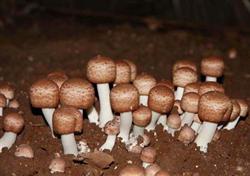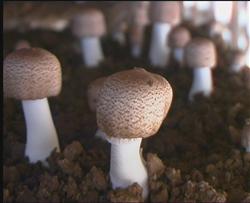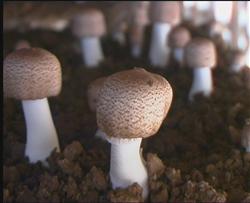How can Agaricus blazei Murrill be planted with high yield?

How can Agaricus blazei Murrill be planted with high yield? Netizens can refer to the following methods for planting Agaricus blazei Murrill: Agaricus blazei Murrill growth conditions: Agaricus blazei Murrill and Agaricus bisporus, Pleurotus ostreatus have similar biological characteristics. The mycelial growth temperature of Agaricus blazei Murrill was 10 ℃ ~ 30 ℃, and the optimum temperature was 22 ℃ ~ 26 ℃. The well-grown hyphae can withstand high temperature, are not afraid of drought, and have good moisture resistance and strong adaptability. The temperature of fruiting body formation and growth is 20 ℃ ~ 33 ℃, and the optimum temperature is 22 ℃ ~ 25 ℃, which is stronger than that of other mushroom edible fungi. The moisture requirement of Agaricus blazei Murrill culture material and overlying soil layer is 60%-65%, the relative temperature of mycelium growth is 60%-75%, and the relative humidity of fruiting body formation and growth is 70%-85%. The optimum pH value of culture material is 6.5-6.8. A large amount of fresh air is needed for fruiting bodies to form. Key points of cultivation techniques of Agaricus blazei Murrill 1. Timely production of Agaricus blazei Murrill strains: for example, in Nanjing area, the mother seed (primary strain) is generally produced in March, the original seed (secondary strain) in April, and the cultivated seed from May to June. The mother seed was cultured in potato glucose medium (PDA) and incubated in a thermostat after inoculation. When producing the original seed and cultivated seed, the fermented dung grass culture material was packed in a 750 ml strain bottle or in a polypropylene plastic bag of 25 cm 28 cm × 15 cm 18 cm. The mouth of the bag was plugged with cotton stopper and fastened with plastic rope. The culture materials of cultivated species should be rice straw, wheat straw (or cottonseed husk) plus cow and horse manure (or chicken manure, rabbit manure, etc.), plus ammonium sulfate (or urea), phosphate fertilizer hydrated lime, gypsum powder and other materials for stacking and fermentation, then drying, chopping, bottle (bag) disinfection and sterilization, inoculation in a sterile room (box) when the temperature drops to 26 ℃, and then culture and growth in the culture room at a suitable temperature. It takes 40-50 days to grow hyphae. For example, indoor cultivation in Nanjing is suitable for sowing in mid-late August, too late sowing will affect the yield of mushrooms in autumn. Outdoor cultivation (small arch shed) is generally better sown after mid-September. 2. Scientific composting of Agaricus blazei Murrill culture materials: 2500 kg of rice and wheat straw, 2000 kg of dried cow dung or horse dung and 2 200 kg of chicken manure, 50 kg of gypsum powder, 50 kg of superphosphate, 25 kg of hydrated lime and 30 kg of urea. Soybean powder 30kg 40kg or soybean cake 50kg 60kg. First, the dry straw and cow dung were pre-wet and piled up from the ground. The pile was 2.0-2.5 meters wide and a layer of grass and dung was piled into a trapezoid. The pile was 6-7 layers and 1.5 meters high. After the pile is finished, if there is water seeping around, pour it on the haystack to keep the surface layer of the haystack from being too dry. After 3 days, the heap was heated up due to fermentation. After 6-7 days, the heap needs to be turned once when the material temperature rises above 60 ℃, and then every 3-4 days for a total of 25-28 days. After fermentation, the rice straw becomes tea-brown, relatively soft, broken by hand, and has a special smell, which indicates that the material has been piled up. If the secondary fermentation method is adopted, the outdoor pre-fermentation only needs to be piled up for 12 days, and then the post-fermentation treatment will be carried out. 3. Do a good job in mushroom management: Agaricus blazei Murrill culture material should be moved into the mushroom room while it is hot, then let it cool naturally, and the stacking material should be shaken loose and paved, and the humidity should be adjusted to 65%, the pH value is 6.5 to 6.8, the thickness of each layer is about 20 cm, and the material temperature is reduced to below 25 ℃ to sow seeds. Inoculate a hole every 15 to 20 centimeters square, bury the bacteria in the material, and then cover some culture material. About 1.5 kilograms of bacteria are needed per square meter. After 15-20 days of sowing, the hyphae basically spread evenly to the mushroom bed culture material, and the soil should be covered at this time. First cover a layer of longan-sized clods, and spray water to keep moist, wait to see the mycelium through the soil seam, and then cover a layer of soybean-sized soil particles, also spray water to moisturize. Moisture can neither be too wet nor too dry. There is no fertilizer in the covered soil, so the sandy loam with good water retention and air permeability is suitable. Agaricus blazei Murrill needs a lot of oxygen and carbon dioxide during mushroom emergence. Good ventilation should be maintained during mushroom emergence. The top of the mushroom house should have a drawer, and four walls should have ventilation windows. Mushroom house management should be flexible according to weather conditions, indoor air humidity should be maintained at 75% to 85%. After sowing, the hyphae will form buds after 30-40 days of development, that is, mushrooms begin to emerge. About 3 days after the fruit body is unearthed, it is suitable to harvest when the mushroom cover has not yet been unfolded (4cm in diameter). Generally, mushrooms can be produced once every 10 days, and 5-6 times can be harvested during the whole growing period. The bed should be cleaned and watered thoroughly after each harvest. When the fruiting body grows to the size of soybeans, the amount of spraying water should be increased to promote normal growth and rapidly increase the yield. Agaricus blazei Murrill, which is generally used as a processing export, should be harvested and dried in time according to the requirements, that is, the mushroom cap has not yet been carried out, the diameter of the mushroom cap is about 5 cm, and the stalk is 1.5-2 cm long. If it is sold on the market as fresh mushrooms, it can be sold 1 or 2 days later, in order to increase the total output and increase the benefit. Click to get more planting techniques of Agaricus blazei Murrill
- Prev

Cultivation of Agaricus blazei Murrill: how does Agaricus blazei Murrill accelerate bud?
How does Agaricus blazei Murrill accelerate buds? Is there any good idea? Ask experienced netizens to introduce and guide the farming network to sort out the budding methods of Agaricus blazei Murrill, which are listed below for netizens' reference. Method 1. The conditions for the formation of mushroom buds: the temperature is 15 ℃ ~ 22 ℃, the temperature difference between day and night is 8 ℃ ~ 10 ℃, and the air relative humidity is 8.
- Next

How to manage Agaricus blazei Murrill after picking?
How to manage Agaricus blazei Murrill after picking? Please introduce that it is more suitable to harvest Agaricus blazei Murrill when the fruiting body is 5cm to 15cm high and has not yet opened the umbrella. Agaricus blazei Murrill can harvest 3-5 stubble mushrooms in one cultivation cycle. Clean up the mushroom feet and fragments on the mushroom bed, fill the pit with new soil and stop spraying water.
Related
- Fuxing push coffee new agricultural production and marketing class: lack of small-scale processing plants
- Jujube rice field leisure farm deep ploughing Yilan for five years to create a space for organic food and play
- Nongyu Farm-A trial of organic papaya for brave women with advanced technology
- Four points for attention in the prevention and control of diseases and insect pests of edible fungi
- How to add nutrient solution to Edible Fungi
- Is there any good way to control edible fungus mites?
- Open Inoculation Technology of Edible Fungi
- Is there any clever way to use fertilizer for edible fungus in winter?
- What agents are used to kill the pathogens of edible fungi in the mushroom shed?
- Rapid drying of Edible Fungi

